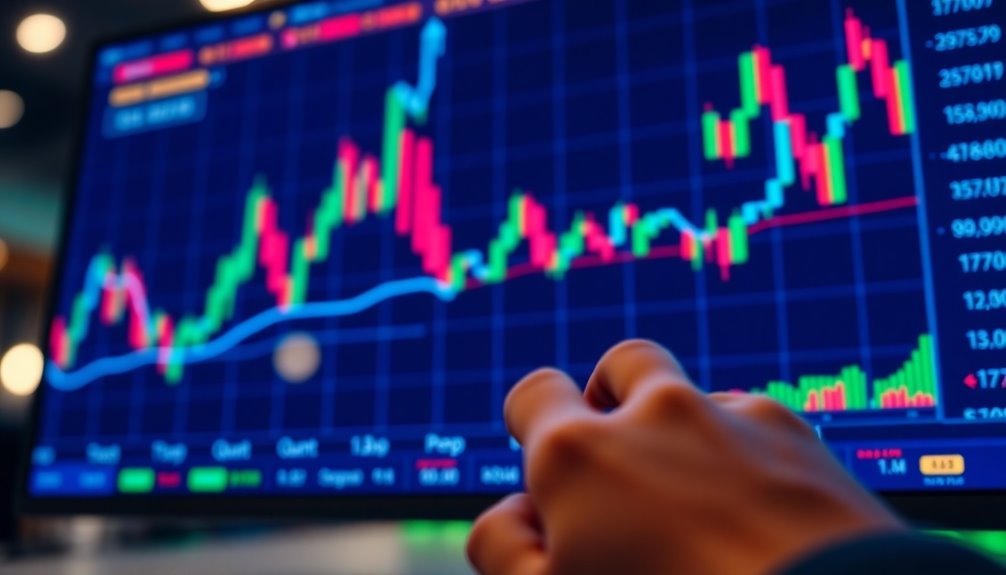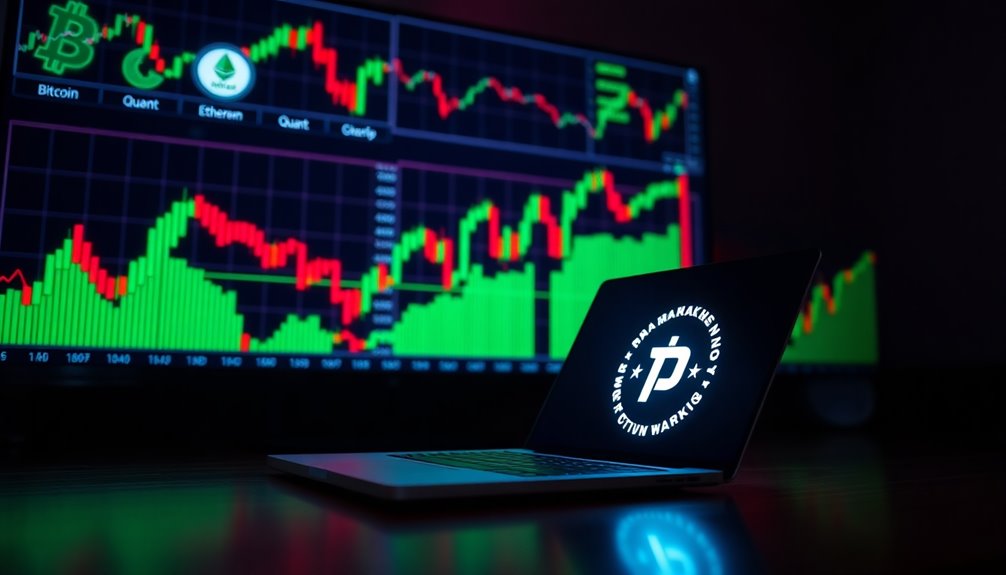Today's crypto market's buzzing! Bitcoin (BTC) is trading around $99,500, inching closer to that $100,000 mark, while Ethereum (ETH) is up 66% this past month at $3,548. Quant (QNT) shows solid interest with a volume of $276.95 million and a 5.11% rise in 24 hours. Pepe Coin (PEPE) is attracting attention as well, trading around $0.000001017 with a considerable volume. Uniswap's growth is impressive, with a total exchange volume surpassing $2 trillion. Keep an eye on the market trends, as there's so much more to unpack and explore!
Key Takeaways
- Bitcoin (BTC) is trading at $99,500, approaching its psychological resistance level of $100,000, with a bullish trend observed in the market.
- Ethereum (ETH) is priced at $3,548.64, reflecting a 66% increase over the past month amid rising trading activity.
- Quant (QNT) has a trading volume of approximately $276.95 million, indicating strong investor interest with a recent 5.11% increase.
- Pepe Coin (PEPE) is currently valued at $0.000001017, with a trading volume of $42 million and a total supply of 420.69 trillion tokens.
- Uniswap has experienced significant growth, with daily trade counts between 36,000 and 78,000 and cumulative exchange volume exceeding $2 trillion.
Bitcoin Market Analysis

As of now, Bitcoin is trading at $99,500, hovering near the significant psychological level of $100,000. Recently, it crossed the $100,000 mark, hitting an all-time high of $104,088. This price consolidation indicates a potential upside breakout, especially with minor gains of 0. 53% over the last 24 hours. The overall trend remains bullish, as the price stays above key moving averages. The recent bitcoin trading surge has prompted many investors to take a closer look at the cryptocurrency market, with some predicting an even greater upside potential. Some analysts believe that the current consolidation phase could be a precursor to another significant price spike, potentially pushing bitcoin even higher. As the market continues to show signs of strength and resilience, many are optimistic about the future of bitcoin trading.
Currently, Bitcoin trades above the 50, 100, and 200 Simple Moving Averages, which support its upward momentum. The Relative Strength Index (RSI) sits at 65.97, close to overbought territory but still healthy, while the Money Flow Index (MFI) shows neutral buying pressure at 59.70. Additionally, the broader crypto market has been energized by macroeconomic events that have lifted investor enthusiasm.
A spinning top candle at these levels signals indecision, yet strong support levels exist at $85,000 and $92,000, with a pivot point at $95,138.09.
Resistance levels to watch are at $105,000 and $120,000, with the first resistance at $105,411.73. As macroeconomic events influence the market, Bitcoin remains a key player, impacting overall crypto sentiment and trends.
Ethereum Price Movements

Ethereum is currently experiencing notable price movements, with its value around $3,548.64 USD as of December 10, 2024. Just a few days ago, on December 5, ETH surged to $3,861, even testing an intraday high of $3,908. However, it's since faced some fluctuations, dropping to $3,541.17 on the latest update.
Overall, Ethereum's price has jumped by 66% over the past month, and expectations for December suggest it might range between $3,528.53 and $3,693.62. Additionally, the projected potential ROI for Ethereum in 2025 is estimated at 60.1%, indicating strong future growth prospects.
Technical indicators reveal a strong bullish sentiment. The price sits near the upper band of the Bollinger Bands, hinting at increased volatility. The Relative Strength Index (RSI) is at 51.88, indicating neutral momentum.
Despite challenges, ETH has broken through significant descending trendlines from prior highs above $5,000, with resistance looming around the $3,900 to $4,100 mark.
Market sentiment remains overwhelmingly bullish, with 82% of traders optimistic and a Fear & Greed Index score of 76. Significant transactions totaling $64 billion in the last 24 hours reflect robust market activity, further fueled by institutional interest, including BlackRock's hefty purchase of $230.39 million in Ethereum.
Quant Overview

Quant (QNT) stands out in the crypto landscape as the native token of the Quant Network, launched in June 2018 as an ERC-20 token. It powers the Overledger, an Ethereum-based distributed ledger technology (DLT) operating system designed to facilitate interoperability among various blockchains. This token offers multiple utilities, including payments, staking, locking, and licensing fees, and it currently ranks 75th on CoinMarketCap by market capitalization.
As of now, QNT's price is around $169.50, reflecting a 5.11% increase in the last 24 hours. Analysts are bullish for 2024, predicting prices to range from $84.6 to $318.8, while bearish forecasts suggest a low of $40. Despite these fluctuations, there's potential for QNT to reach $200 or even surpass its all-time high of $428.38 if market momentum remains positive. Additionally, the current trading volume of approximately $276.95M indicates strong investor interest in QNT.
Recently, QNT has shown a strong upward trend, increasing by 6.25% over the past week and 10.43% this month. The Alligator lines indicate a perfect bullish alignment, confirming ongoing upward momentum, although a negative Volume Oscillator suggests declining trading volume.
Pepe Coin Insights

Pepe Coin has quickly made a name for itself in the crypto world since its launch on April 15, 2023. Initially launched as a meme coin on the Ethereum blockchain, it achieved an impressive market capitalization of over $5 billion shortly after its debut, reflecting a staggering price increase of nearly 7000%. However, the current market cap fluctuates between $200 million and $427 million.
Here's a snapshot of Pepe Coin's key metrics:
| Metric | Value |
|---|---|
| Total Supply | 420.69 trillion PEPE tokens |
| Current Price | $0.000001017 USD |
| 24-hour Trading Volume | $42 million |
| Market Cap Range | $200 million – $427 million |
Pepe Coin employs a deflationary mechanism, burning a small percentage of tokens with each transaction, creating scarcity. While it started with a redistribution system for holders, discussions about discontinuing this feature are ongoing. Challenges arose in August 2023, but recent token burns and new advisors are helping to restore confidence. Notably, Pepe Coin is classified as a meme coin, which has contributed to its passionate community. You can trade Pepe Coin on various exchanges, including Uniswap, using a compatible Ethereum wallet.
Uniswap Token Dynamics

Uniswap has emerged as a leading decentralized exchange, showcasing impressive growth and innovation in the crypto space. In 2024, you'll notice a staggering 725,000 unique tokens exchanged, a leap from the previous years. The number of portfolios has surged from 3 million to 7.2 million, marking a 140% increase. This remarkable growth in unique tokens exchanged highlights the platform's expanding appeal to users.
With a cumulative exchange volume exceeding $2 trillion by April, daily trade counts peak between 36,000 and 78,000, underlining Uniswap's active trading environment.
The recent fee structure change, raising trading fees from 0.15% to 0.25%, has generated significant revenue, collecting $661,000 by May 2024. These fees are fully allocated to liquidity providers, possibly attracting more participants to the platform.
Technologically, Uniswap's launch of the Layer-2 scaling solution, Unichain, has cut Ethereum's transaction fees by 95%, enhancing user experience and efficiency.
As for token performance, the UNI price recently surged 32% after Unichain's launch, with predictions suggesting it could reach $13.2 in 2024.
With high liquidity in pools, you can expect reduced price volatility, making trading smoother and more efficient.
Global Market Trends

The global cryptocurrency market is on a remarkable growth trajectory, projected to expand from $2.16 billion in 2023 to $2.49 billion in 2024, reflecting a robust compound annual growth rate (CAGR) of 15.5%.
By 2028, this market could soar to $4.59 billion, with a CAGR of 16.5%, driven by increasing adoption from individuals, businesses, and institutions.
You'll notice that institutional acceptance and the rise of decentralized finance (DeFi) are key catalysts for this growth.
Technological advancements, particularly in blockchain technology, are also making a significant impact.
As you track these trends, remember that regulatory clarity and government endorsements for digital currencies, like Central Bank Digital Currencies (CBDCs), are shaping the landscape.
Moreover, the increasing popularity of digital assets such as Bitcoin and Ethereum is evident. The market is segmented by type, including Bitcoin, Ethereum, Bitcoin Cash which aids in understanding market dynamics.
Countries are embracing cryptocurrencies for financial exchanges, with a notable 650% increase in cryptocurrency holders in the UK from 2021 to 2023.
All these factors indicate a thriving future for the cryptocurrency sector, making it an exciting time for investors and enthusiasts alike.
Trading Volume Insights

Recent trading volume data reveals that the cryptocurrency market is experiencing significant activity, with an estimated total volume of $1.17 trillion in just the last 24 hours.
Bitcoin (BTC) leads the pack with a daily trading volume of approximately $111 billion, showcasing its crucial role in market dynamics. This volume reflects both heightened interest and the inherent volatility of Bitcoin, especially as it fluctuates between peaks and declines. As of Dec 02, 2024, there are approximately 311,811 daily transactions occurring on the Bitcoin network, indicating a noteworthy change in user activity.
Ethereum (ETH), while not specified directly, contributes meaningfully to the overall volume, particularly during price volatility. Recent bullish trends indicate that trading activity for Ethereum is on the rise, mirroring broader market movements.
In the altcoin space, assets like Quant (QNT), Pepe, and Uniswap are also seeing increased trading volumes, signaling growing investor interest.
However, Quant's negative Volume Oscillator hints at a decline despite its uptrend.
Market Sentiment Analysis

As trading volumes surge in the crypto market, understanding market sentiment becomes increasingly important for investors. Currently, the Crypto Fear and Greed Index sits at 72, indicating a balanced uptrend but hinting at elevated risk for a pullback. You should note that high levels of greed often precede market corrections, so it's crucial to stay vigilant. Additionally, the recent Bitcoin's volatility has drawn attention, emphasizing the need for careful analysis and timing in trading decisions.
Monitoring social media platforms like X, Reddit, and Telegram can provide insight into community sentiment. Increasing positive discussions about cryptocurrencies signal growing interest, while negative comments can indicate bearish trends. This community engagement greatly influences market sentiment, so keep an eye on ongoing conversations.
Additionally, news coverage plays a pivotal role in shaping public perception. Positive media can enhance sentiment and prices, while negative reports can drive them down. Regulatory news is particularly influential, so be aware of any notable announcements.
Lastly, consider recent price movements. Bitcoin's fluctuations around the $100K mark have certainly affected sentiment. Upward trends usually correlate with increased greed, while downtrends reflect fear. By closely monitoring these factors, you'll be better equipped to navigate the ever-changing crypto landscape.
Notable Altcoin Performances

Altcoins are grabbing the spotlight in the crypto market, with several showing impressive performances that attract both retail and institutional investors. You'll notice that coins like XRP, Algorand, and Telcoin are outperforming as investors seek higher returns. Increased activity in altcoins such as HBAR, IMX, SUI, and AERO suggests that participants are adding these assets to their portfolios. The growing interest in altcoins is evident, as clients are favoring bids on these assets.
Specific altcoins are catching your eye, too. Litecoin (LTC) is poised for a move upward, while Cosmos (ATOM) and Polkadot (DOT) are expected to thrive within the Ethereum ecosystem. Furthermore, the recent surge in Bitcoin surpassing $100,000 has led to increased interest in altcoins as investors diversify their holdings.
PEPE and DOGE show bullish divergence, backed by rising volumes indicating strong support. Ethereum token RCO Finance (RCOF) is also likely to have a bullish run. However, keep an eye on broader market risks, including geopolitical tensions and policy changes. Despite these challenges, profit-taking in major cryptocurrencies has pushed some investors towards altcoins.
You might want to take into account Avalanche (AVAX), Polygon (POL), and Qubetics ($TICS) for their unique growth potential in this evolving landscape.
Frequently Asked Questions
What Factors Influence Bitcoin's Price Fluctuations?
Bitcoin's price fluctuations are influenced by several key factors.
You'll notice that supply and demand dynamics play a vital role, especially with its capped supply.
Market sentiment, driven by news and speculation, can cause rapid price changes.
Regulatory developments, whether positive or restrictive, also impact investor confidence.
Additionally, technological advancements and external events, like political statements, can drive volatility.
Staying informed about these elements helps you navigate Bitcoin's price movements effectively.
How Does Ethereum's Gas Fee Impact Traders?
Imagine you're a sailor steering through a bustling harbor. Ethereum's gas fees are like the tides—high when the water's crowded, making it tough to dock your ship.
If you don't account for these rising waters, your profits can sink. Delayed transactions due to low gas prices might cause you to miss vital trades, while high fees guarantee you sail smoothly, albeit at a cost.
Balancing urgency and expense is key to your trading journey.
What Is Quant's Role in Blockchain Interoperability?
Quant plays an essential role in blockchain interoperability by serving as a gateway network, connecting various distributed ledgers and existing systems.
It lets you transfer assets and data seamlessly across different blockchains, improving efficiency and reducing reliance on intermediaries.
With its Overledger technology, you can create multi-chain applications, enhancing usability and scalability while ensuring security and compliance.
Ultimately, this revolutionizes how businesses integrate blockchain into their operations.
Why Is Pepe Considered a Meme Coin?
Imagine a playful frog hopping through the vast pond of cryptocurrencies, charming everyone with its humor.
That's why you see Pepe as a meme coin. It's built on the popular internet meme, lacking intrinsic value or utility beyond its playful nature.
While it captures the spirit of pop culture, it thrives on community engagement. Its whimsical essence appeals to collectors, making it more of a token of fun than a serious investment.
How Does Uniswap's Governance Work?
Uniswap's governance operates through a decentralized autonomous organization (DAO) model, allowing you, as a UNI token holder, to influence decisions.
You can submit proposals if you hold 1% or more of the total UNI supply. The process begins in the Governance Forum, moves to a temperature check, and culminates in a formal on-chain vote lasting 7 days.
Your voting rights can be delegated, enhancing your participation in governance.
Conclusion
In conclusion, keeping an eye on Bitcoin, Ethereum, and altcoins like Quant, Pepe, and Uniswap can help you navigate the ever-changing crypto landscape. While it might seem overwhelming, remember that even seasoned traders started where you are now. Embrace the learning process, and don't hesitate to explore new investments. With the right mindset and a bit of research, you can make informed decisions and seize opportunities in this dynamic market. Happy trading!









